Hydropower is held up as the beacon of hope for millions of Cambodians starved for electricity, with 10 planned hydro-dams set to power up their homes for the first time.
But flicking the switch comes at a price as critics say the controversial deals made with mostly Chinese companies to build the dams will create further hardship for Cambodia’s poor and ruin the environment.
For window-maker Dorn Seanghor, however, the prospect of working without being plunged into darkness is appealing. In the midst of Cambodia’s building boom his business should be thriving, but he is constantly frustrated.
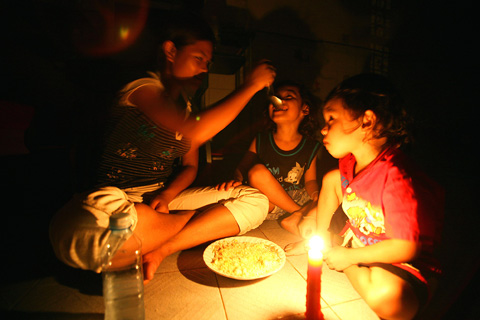
PHOTO: AFP
“There’s usually a blackout for six to eight hours almost every day — one time in the morning and again in the evening,” he said at his shop in Phnom Penh.
“It disturbs my business. I use a generator when the power is cut, but the price of gasoline is very high now,” he said.
Still, Dorn Seanghor is one of the luckier ones. Four-fifths of Cambodians do not have access to any electricity.
Ten dams are set to begin churning between 2010 and 2019, and once they are all operational the government says they will generate 2,045 megawatts of power, serving all Cambodia’s provinces.
Government officials say six of the dams will be funded by Chinese companies, but the US-based International Rivers Network warned in a January report that these Chinese investments could threaten some of Cambodia’s most precious eco-systems.
“Poorly conceived hydropower development could irreparably damage [natural] resources,” the report warned.
Groups have been particularly concerned about the looming effects of Kamchay Dam, under construction by Sinohydro Corp in Bokor National Park and expected to flood 2,000 hectares of protected forest.
And now environmental groups say two more projects agreed to earlier this month at a cost of more than US$1 billion — Stung Tatay by China National Heavy Machinery Corp and Russey Chrum Krom by Michelle Corp — have not been properly scrutinized.
Both will be located in the country’s southwestern Cardamom Protected Forest, and about 1,600 hectares of woodland would have to be flooded or cleared to make way for the dams, the government has said.
This could destroy key animal habitats and upset the delicate eco-system.
“Cardamom is the last hot spot of conservation in Indochina,” said Sam Chanthy, an environmental officer with advocacy group Forum on Cambodia.
Qian Hai, third secretary of the Chinese embassy in Phnom Penh, denied his country’s companies would damage the environment.
“We just help Cambodia. All these projects are approved by the parliament and the government,” he said.
Ith Praing, Cambodia’s energy secretary, insisted the government conducted careful environmental studies for all the dams.
“Outsiders always raise environmental issues, but we need electricity. We must develop our country. We must use our resources rather than buying oil,” he said.
Cambodia has begun to climb back from decades of civil unrest to emerge as one of the region’s fastest-growing economies.
Economic growth has averaged 11 percent over the past three years, although 30 percent of the 14 million people still earn less than US$1 per day.
The government fears rocketing energy prices will scare away foreign direct investment.
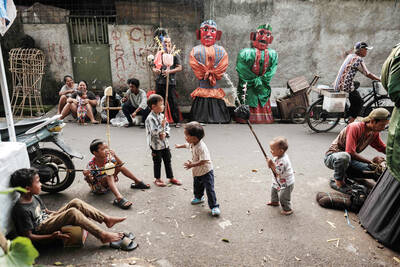
In the sweltering streets of Jakarta, buskers carry towering, hollow puppets and pass around a bucket for donations. Now, they fear becoming outlaws. City authorities said they would crack down on use of the sacred ondel-ondel puppets, which can stand as tall as a truck, and they are drafting legislation to remove what they view as a street nuisance. Performances featuring the puppets — originally used by Jakarta’s Betawi people to ward off evil spirits — would be allowed only at set events. The ban could leave many ondel-ondel buskers in Jakarta jobless. “I am confused and anxious. I fear getting raided or even
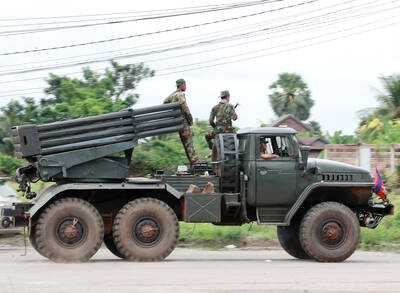
POLITICAL PATRIARCHS: Recent clashes between Thailand and Cambodia are driven by an escalating feud between rival political families, analysts say The dispute over Thailand and Cambodia’s contested border, which dates back more than a century to disagreements over colonial-era maps, has broken into conflict before. However, the most recent clashes, which erupted on Thursday, have been fueled by another factor: a bitter feud between two powerful political patriarchs. Cambodian Senate President and former prime minister Hun Sen, 72, and former Thai prime minister Thaksin Shinawatra, 76, were once such close friends that they reportedly called one another brothers. Hun Sen has, over the years, supported Thaksin’s family during their long-running power struggle with Thailand’s military. Thaksin and his sister Yingluck stayed
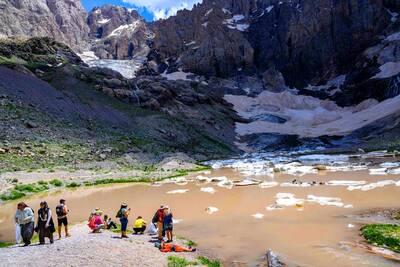
Kemal Ozdemir looked up at the bare peaks of Mount Cilo in Turkey’s Kurdish majority southeast. “There were glaciers 10 years ago,” he recalled under a cloudless sky. A mountain guide for 15 years, Ozdemir then turned toward the torrent carrying dozens of blocks of ice below a slope covered with grass and rocks — a sign of glacier loss being exacerbated by global warming. “You can see that there are quite a few pieces of glacier in the water right now ... the reason why the waterfalls flow lushly actually shows us how fast the ice is melting,” he said.
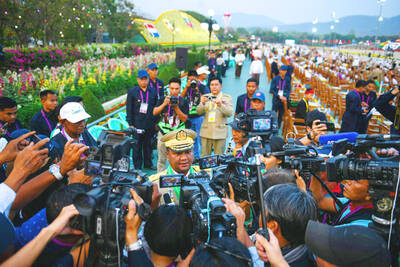
RESTRUCTURE: Myanmar’s military has ended emergency rule and announced plans for elections in December, but critics said the move aims to entrench junta control Myanmar’s military government announced on Thursday that it was ending the state of emergency declared after it seized power in 2021 and would restructure administrative bodies to prepare for the new election at the end of the year. However, the polls planned for an unspecified date in December face serious obstacles, including a civil war raging over most of the country and pledges by opponents of the military rule to derail the election because they believe it can be neither free nor fair. Under the restructuring, Myanmar’s junta chief Min Aung Hlaing is giving up two posts, but would stay at the